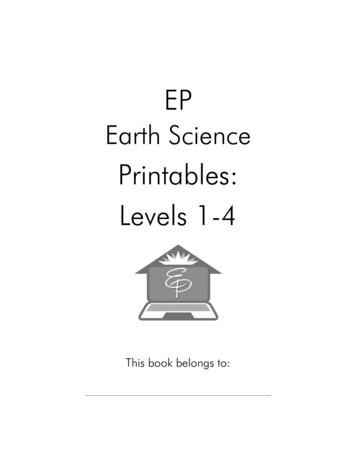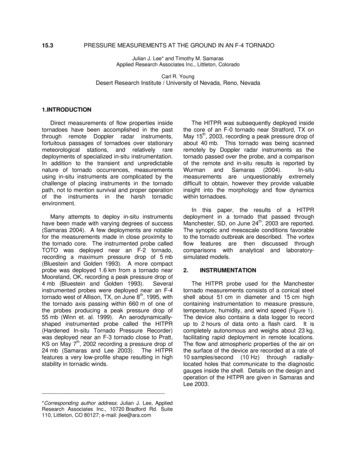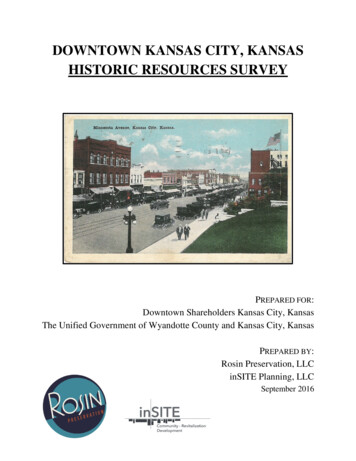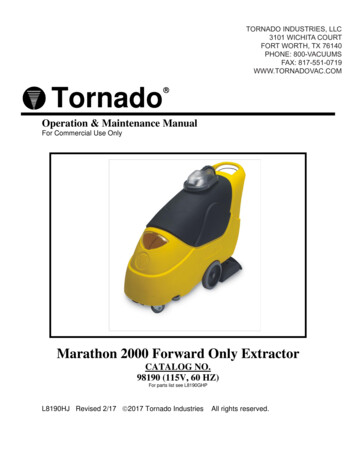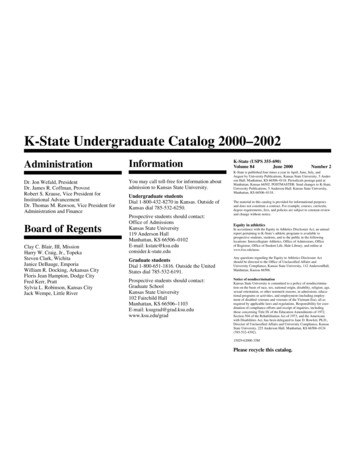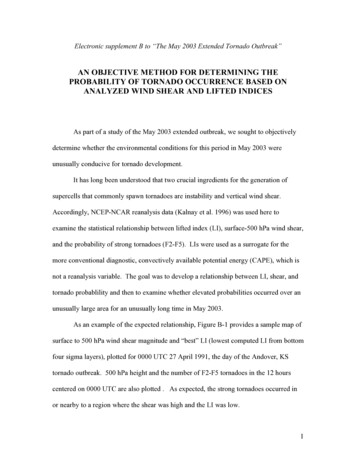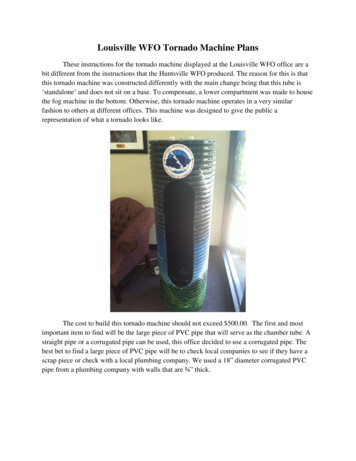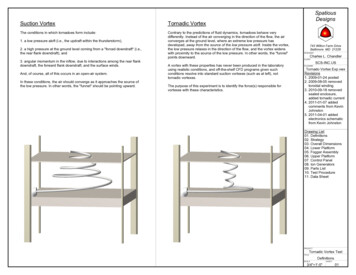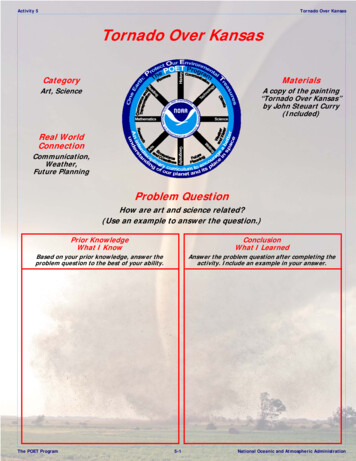
Transcription
Activity 5Tornado Over KansasTornado Over KansasCategoryMaterialsArt, ScienceA copy of the painting“Tornado Over Kansas”by John Steuart Curry(Included)Real WorldConnectionCommunication,Weather,Future PlanningProblem QuestionHow are art and science related?(Use an example to answer the question.)Prior KnowledgeWhat I KnowConclusionWhat I LearnedBased on your prior knowledge, answer theproblem question to the best of your ability.Answer the problem question after completing theactivity. Include an example in your answer.The POET Program5-1National Oceanic and Atmospheric Administration
Activity 5Tornado Over KansasBackgroundAlthough we tend to separate art and science into different categories, these seemingly opposite areasof work and study are often closely related. For example, an architect combines art and the science ofengineering when designing a building. The engineering aspect ensures that the building is stable, canwithstand high winds and rain and will last a reasonable amount of time. Art influences the shape ofthe building and the character of its exterior and interior, and ensures that it is pleasing to the eye,perhaps even striking.Procedure - Part 1Have you ever thought I don’t need towrite becauseI am goingto be anartist.”“Why should Ihave to learnhow to writeessays Fill-in the quadrangle below with anysubject that does not interest you.Fill-in the quadrangle below with yourreason for not wanting to learn the subject.Why should I have to learn because I am If you have similar thoughts, you have lots of company.Yet in reality, nobody knows whatthe future holds. Indeed, oursurvival and the survival of ourloved ones may one day dependupon our own “preparedness”.The POET ProgramLike it or not, weneed to prepare forunknown events.5-2Here is oneevent thatyou mightencounter.National Oceanic and Atmospheric Administration
Activity 5Tornado Over KansasFigure 5-1. “Tornado Over Kansas” Painting by John Steuart Curry – 1929.(Use of Curry painting courtesy of the Muskegon Art Museum, Muskegon, Kansas)The artist of “Tornado Over Kansas”, John Steuart Curry(1897 - 1946) was an American painter who tried torealistically represent the American people, their history,and their stories. Sensitive to the feelings of sadness andlost dreams brought about by the Great Depression in the1920s and 1930s, Curry attempted to help fellow citizensregain a sense of pride with his art work.1.What can you observe and infer about the people?2.What can you observe and infer about the weather?3.What other things can you observe in the painting and then infer about the artist?Fill-in the tables on the next page (Table 5-1) with your observations and inferences.The POET Program5-3National Oceanic and Atmospheric Administration
Activity 5Tornado Over onsInferencesDoor to theShelter is OpenPeople Plan toEnter the ShelterGreen SkyHailThe Artist – John Steuart CurryObservationsInferencesColors are RealisticArtist Knows Chemistryof Mixing PaintTable 5-1. Observations and Inferences using Figure 5-1.The POET Program5-4National Oceanic and Atmospheric Administration
Activity 5Tornado Over KansasProcedure - Part 2Choose one of the exercises from the list below. Follow directions using the space provided.1.Write one paragraph that describes when either you or someone you know experienced someunusual weather, not necessarily a tornado.2.Sketch a situation where either you or someone you know experienced some unusual weather.3.Use “bullets” in a list to describe a situation where either you or someone you know experiencedsome unusual weather.Procedure - Part 3Using the NOAA/NWS Tornado Safety information at the rest of this activity, prepare a home plan foryour family. Include where to meet, where to take shelter, responsibilities for each family member.andPRACTICE!The POET Program5-5National Oceanic and Atmospheric Administration
Activity 5Tornado Over KansasTornado Preparedness Plan for the() FamilyPlace to MeetWhere to Go for ShelterName of Each Family Memberwith His/Her ResponsibilitiesThe POET Program5-6National Oceanic and Atmospheric Administration
Activity 5Tornado Over KansasAdditional Information on Tornado SafetyThere is no such thing as guaranteed safety inside atornado. Freak accidents happen; and the most violenttornadoes can level and blow away almost anyhouse and its occupants. Extremely violent F5tornadoes are very rare, though. Most tornadoes areactually much weaker and can be survived using thesesafety ideas.Prevention and Practice Before the StormAt home, have a family tornado plan in place, based onthe kind of dwelling you live in and the safety tips thatfollow.Know where you can take shelter in a matter ofseconds, and practice a family tornado drill at leastonce a year.Have a pre-determined place to meet after a disaster.Flying debris is the greatest danger in tornadoes; sostore protective coverings (e.g., mattress, sleepingbags, thick blankets, etc) in or next to your shelterspace, ready to use on a few seconds' notice.Figure 5-2. This is classic F5 damage. TheBridge Creek/Moore, Oklahoma, tornado of3 May 1999 leveled this house, swept thefoundation almost completely clean,shredded the house remains into smallpieces and scattered the debris downwindto the northeast (rear). The house wasrelatively well-constructed with slab-to-wallanchor bolts evenly spaced around thebottom plate. Some of those bolts can beseen in this photo, protruding upward fromjust inside the edges of the concrete slab.When a tornado watch is issued, think about the drilland check to make sure all your safety supplies arehandy. Turn on local TV, radio or NOAA Weather Radioand stay alert for warnings.Forget about the old notion of opening windows toequalize pressure; the tornado will blast open thewindows for you!If you shop frequently at certain stores, learn wherethere are bathrooms, storage rooms or other interiorshelter areas away from windows, and the shortestways to get there.All administrators of schools, shopping centers,nursing homes, hospitals, arenas, stadiums, mobilehome communities, and offices should have a tornadosafety plan in place, with easy-to-read signs posted todirect everyone to a safe, close-by shelter area.Schools and office building managers should regularlyrun well-coordinated drills.If you are planning to build a house, especially east ofthe Rockies, consider an underground tornado shelteror an interior "safe room“.The POET Program5-7Figure 5-3. An example of tornado debristhat has been turned into a flying projectile.National Oceanic and Atmospheric Administration
Activity 5Tornado Over KansasFigure 5-4. An example of a building’s tornadosafety plan sign directing people to safe places.Figure 5-5. An example of a tornado “saferoom” for either exterior or interior home use.In a House With a BasementAvoid windows. Get in the basement and under some kind of sturdyprotection (heavy table or work bench), or cover yourself with a mattress orsleeping bag. Know where very heavy objects rest on the floor above (pianos,refrigerators, waterbeds, etc.) and do not go under them. They may fall downthrough a weakened floor and crush you.In a House with No Basement, a Dorm, or an ApartmentAvoid windows. Go to the lowest floor, small center room (like a bathroom orcloset), under a stairwell, or in an interior hallway with no windows. Crouchas low as possible to the floor, facing down; and cover your head with yourhands. A bath tub may offer a shell of protection. Even in an interior room,you should cover yourself with some sort of padding (mattress), blankets,etc.), to protect against falling debris in case the roof and ceiling fail.Figure 5-6. A mattressamong tornado debris.In a Mobile HomeGet out! Even if your home is tied down, you are probably safer outside, evenif the only alternative is to seek shelter out in the open. Most tornadoes candestroy even tied-down mobile homes; and it is best not to play the low oddsthat yours will make it. If your community has a tornado shelter, go therefast. If there is a sturdy permanent building within easy running distance,seek shelter there. Otherwise, lie flat on low ground away from your home,protecting your head. If possible, use open ground away from trees and cars,which can be blown onto you.Figure 5-7. Tornadodebris inside a house.Figure 5-9. Stairwell among debris.The POET ProgramFigure 5-8. Bath tub among debris.5-8National Oceanic and Atmospheric Administration
Activity 5Tornado Over KansasAdditional Information on the Painting “Tornado Over Kansas”From The Grace Museum – Education – Teacher Resources“Tornado over Kansas” by John Steuart Curry captures a terrifying incident on a Midwesternfarm as a family rushes to the storm shelter to escape a rapidly approaching twister, one of themost fearful natural disasters on earth. A sickly green light permeates the scene as the tornadodrops down to the ground from an ominous layer of dense, brownish-black clouds. A sense ofterrible urgency pervades the scene.The father, pictured as a heroic figure, pulls his barefoot daughter by the hand and protectivelylooks back to see that his sons are following closely behind. The mother pauses at the entranceto the shelter, cradling her baby in a patchwork quilt and looking back at her family with fearand alarm.The cyclone seems to have struck with little warning, as the family has had time to gather onlywhat they hold most dear – each other and their pets. An older boy carries three small puppiesas their brown- and white-splotched mother anxiously looks upward towards them. A youngerboy is desperately trying to hold on to an uncooperative black cat. In the near distance, horseswheel in frenzied panic directly in the path of the rapidly advancing tornado. The onlyunconcerned participant in this drama is a white chicken standing at the foot of the stairs, to allappearances, oblivious to imminent danger.Painted in 1929, Tornado over Kansas presents visual evidence of the hard life experienced byfarm families in the Midwest and West. The man and his boys wear overalls, the workinggarment of the time, and the two younger children are barefoot. The mother probably mademost of their clothes and used leftover scraps of fabric to make the patchwork quilt thatswaddles her baby.The weatherworn house and outbuildings are plain, and the only toy visible is a simple child’spull cart. No evidence of electric power is visible; there is a wagon but no car. Farming was adifficult business, always at the mercy of the elements. Natural disasters could arrive at anytime in the form of tornadoes, windstorms, dust storms, blizzards, floods, drought, orgrasshoppers. The life this family has been able to wrest from this ground has been meager buthonest.“Tornado over Kansas” pictures a time just before the Dust Bowl years that devastatedMidwestern farmers such as the artist’s father. Though this painting depicts a particular event,time, and place, it transcends the region through its American icons – the patriarchal father, thefamily, the farmhouse, pets, even a bit of picket fence – at the mercy of an overpowering anddestructive force of nature.As a child growing up in Kansas, the artist John Steuart Curry had firsthand experience oftornadoes. Kansas is the state most associated with tornadoes, due in large part to L. FrankBaum’s popular book, first published in 1900, The Wonderful Wizard of Oz. “Tornado OverKansas” also captured the popular imagination, as it was widely reproduced.Tornado Images in this ActivityActivity Background Tim SamarasThe POET ProgramTornado Preparedness Plan Wayne Hanna Wisconsin State Journal Doug Keister Eric Nguyen5-9National Oceanic and Atmospheric Administration
Activity 5 Tornado Over Kansas The POET Program 5-7 National Oceanic and Atmospheric Administration Additional Information on Tornado Safety There is no such thing as guaranteed safety inside a tornado. Freak accidents happen; and the most violent tornadoes can level and blow awa
